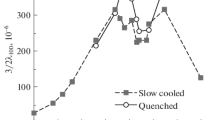Abstract
A series of iron-platinum alloys containing 25 or 27 at. pct platinum and with ordering of the γ-phase varying from substantial disorder to nearly complete order have been thermally cycled between 25°C and - 196°C. The kinetics of the γ⇌α transformations, the hysteresis revealed by electrical resistanceJtemperature plots, the thermoelastic growth and the reappearance of an identical microstructure after thermal cycling (the microstructural memory effect) were studied as a function of the ordering of the γ-phase. Thermoelastic growth does not appear to be affected by changes in the degree of order of partially ordered specimens but the microstructural memory was imperfect in the most highly ordered specimen examined. In agreement with earlier observations by Dunne and Wayman,3 the difference between the As and Ms temperatures and the hysteresis decrease markedly as the order is increased. It is shown by transmission electron microscopy that in all but the most highly-ordered specimens the α- γ transformation produces plates of austenite with a high density of dislocations. These plates are separated from the surrounding untransformed parent austenite by arrays of dislocation loops lying in the interfaces between untransformed parent austenite and the original martensite plates. All the dislocations have a Burgers vector direction which is the same as that of the usual slip dislocation in austenite. Such dislocations lying in a habit plane must be sessile. In the well-ordered specimen dislocation pairs, typical of glide dislocations in a crystal with long-range order, were formed in the austenite formed by the reverse transformation. These dislocations were segregated into roughly plate-like clusters, but the number of clusters in unit volume was appreciably less than the number of original plates of martensite. In this case, no arrays of sessile loops of dislocations mark the locations of the original martensite-austenite interface. It is deduced from the microscopic and kinetic results that the inherited nuclei responsible for the microstructural memory effect are located in localized volumes of highly dislocated austenite formed by the α- γ transformation. No unique dislocation configurations which could be associated with specific nuclei were found. The effects of ordering on the various kinetic effects and the microstructural memory are discussed in terms of the concept of inherited nuclei, the change of the flow stress of the γ-phase with ordering and temperature and the variation of To and the transformation driving-force with ordering.
Similar content being viewed by others
References
A. Kussman and G. Countess of Rittenberg:Z. Metallkunde, 1950, vol. 41, p. 470.
A. E. Berkowitz, F. J. Donahoe, A. D. Franklin, and R. P. Steijn:Acta Met., 1957, vol. 5, p. 1.
D. P. Dunne and C. M. Wayman:Met. Trans., 1973, vol. 4, p. 137.
D. S. Lieberman, M. S. Wechsler, and T. A. Read:J. Appl. Phys., 1955, vol. 26, p. 473.
W. J. Buehler, J. V. Gilfrich, and R. C. Wiley:J. Appl. Phys., 1963, vol. 34, p. 1475.
M. W. Burkart and T. A. Read:Trans. AIME, 1953, vol. 197, p. 1516.
C. J. Jackson, H. J. Wagner, and R. J. Wasilewski:55-Nitinol-The Alloy with a Memory, NASA SP 5110, 1972.
S. Kajiwara and W. S. Owen:Met. Trans., 1973, vol. 4, p. 1988.
L. Kaufman and M. Cohen:Prog. Metal Phys., 1958, vol. 7, p. 165.
R. D. Schoone and E. A. Fischione:Rev. Sci. Instrum., 1966, vol. 37, p. 1351.
E. J. Efsic and C. M. Wayman:Trans. TMS-AIME, 1967, vol. 239, p. 873.
G.Krauss:Acta Met., 1963, vol. 11, p. 499.
J. W. Christian:The Theory of Transformations in Metals and Alloys, Pergamon Press, Oxford, 1965.
J. L. Nilles: Ph.D. Thesis, Cornell University, 1970.
T. Tadaki and K. Shimizu:Trans. Japan Inst. Met., 1970, vol. 11, p. 44.
M. Umemoto and W. S. Owen:Met. Trans., 1974, vol. 5, pp. 2041–46.
C. M. Wayman and K. Shimizu:Metal Sci. J., 1972, vol. 6, p. 175.
Author information
Authors and Affiliations
Additional information
Formerly at Northwestern University
Rights and permissions
About this article
Cite this article
Kajiwara, S., Owen, W.S. The reversible martensite transformation in iron-platinum alloys near Fe3Pt. Metall Trans 5, 2047–2061 (1974). https://doi.org/10.1007/BF02644498
Received:
Published:
Issue Date:
DOI: https://doi.org/10.1007/BF02644498




